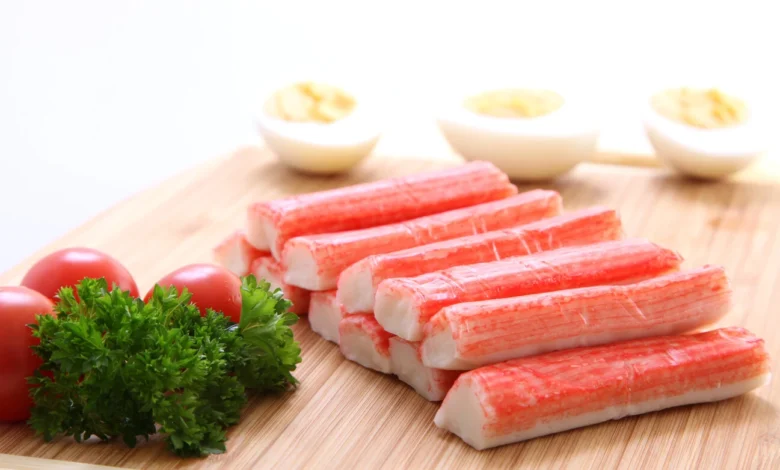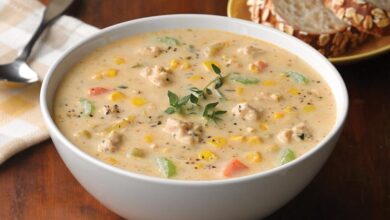Kanikama Discover the Story, Flavor, and Uses of Imitation Crab Meat

If you’ve ever bitten into a California roll or dipped into seafood salad, you’ve likely tasted kanikama a Japanese creation that mimics crab meat using fish paste. Pronounced “ka-nee-ka-ma,” this staple of modern cuisine blends affordability, versatility, and umami-rich flavor. Let’s dive into its origins, ingredients, culinary uses, nutritional value, and reasons for its global popularity.
Table of contents
What Is Kanikama?
Kanikama, often called imitation crab meat or crab sticks, comes from a processed seafood product made of surimi, a fine paste of white fish (commonly Alaskan pollock). Mixed with starch, egg whites, flavorings, and dye. This paste is shaped and cooked to resemble snow crab or Japanese spider crab legs. Its striped appearance and flaky texture allow it to serve as a convincing and affordable alternative to real crab.
A Brief History of This Japanese Staple
The term kanikama combines two Japanese words: “kani” (crab) and “kamaboko” (fish cake). The product was first developed around 1973 by Sugiyo as a flake form, with stick-style versions patented by Osaki Suisan in 1975. By 1977, international exports had launched its global appeal. It quickly became a favorite in sushi bars and mainstream cuisine.
How Kanikama Is Made
Creating kanikama begins with surimi, the refined paste from boneless white fish. This paste gets washed repeatedly to eliminate fat and impurities. Then blended with starch, egg whites, salt, sugar, and flavor enhancers. After mixing, it is extruded into shapes (sticks or flakes), lightly colored on the outside, and steam-cooked. The result is a versatile, shelf-stable ingredient with faux-crab texture.
Culinary Uses Around the World
In Japanese cuisine, kanikama embraced in California rolls, kani sushi, and cold dishes. Globally, it appears in summer rolls, kani salads, crab dip, crab cakes, spring rolls, and even crab-stuffed omelets. Its mild sweetness and firm but flaky texture allow it to adapt to various dishes from simple snacks to complex appetizers and fusion fare.
Nutrition & Health Considerations
Compared to real crab, kanikama provides fewer nutrients. It is lower in protein and richer in carbohydrates and starch. However it also contains sodium, preservatives, and colorants. While safe for moderate consumption nutrition experts note it’s a processed food not a whole-food source of seafood nutrition. It enjoyed occasionally but shouldn’t fully replace nutrient-dense alternatives.
Quick Facts About Kanikama
- Not Real Crab: Made from white fish (usually Alaskan pollock), not actual crab meat.
- Sushi Staple: Commonly found in California rolls, kani salads, and Japanese lunch boxes.
- Global Reach: Originally from Japan, now used in cuisine across the U.S., Europe, and Asia.
- Shelf-Stable: Available frozen, vacuum-packed, or refrigerated with long storage potential.
- Check Labels: Some brands may contain crab extract or allergens—always read ingredients.
- Ready to Eat: Pre-cooked and consumed straight from the pack or added to recipes.
- Cost-Effective: Much cheaper than real crab, making it a popular choice for foodservice and home cooks.
- Highly Processed: Contains added starches, flavorings, and often artificial coloring.
Advantages and Limitations
Kanikama shines for its consistency, affordability, and allergen-friendly profile (it typically contains no shellfish). Its paste formulation allows stable shelf life and easy cooking. On the flip side, it lacks the depth of flavor, antioxidants, and omega-3s found in real crab. Consumers with fish allergies or sensitivities to additives should also stay aware.
Sustainability and Production Practices
Producing kanikama requires resource management. Surimi extraction minimizes waste from fish, but the process uses water and additives responsibly. Some manufacturers now focus on sustainable sourcing of pollock and natural flavorings and dyes. While not perfect, it exemplifies technological adaptation toward resource-efficient seafood substitutes.
Conclusion
Kanikama is proof that ingenuity and necessity can create culinary traditions. As a product of Japanese innovation, it delivers a taste and texture reminiscent of crab without the cost. While it’s not a nutritional replacement for real seafood, its affordability, flexibility, and shelf-stability make it a pantry-friendly alternative worthy of global kitchens.
FAQs
Q1: Does kanikama contain real crab?
No. It’s made entirely from white fish paste, flavored and dyed to mimic crab.
Q2: Is it healthier than real crab meat?
It’s lower in protein and nutrients than crab. It contains starch, sodium, and sometimes additives.
Q3: Can people with shellfish allergies eat kanikama?
Generally yes, but check labels some versions include real crab extract or shellfish allergens.
Q4: How should kanikama be stored?
Store sealed in the fridge or freezer. Thaw in the refrigerator before using and consume within recommended time limits.





